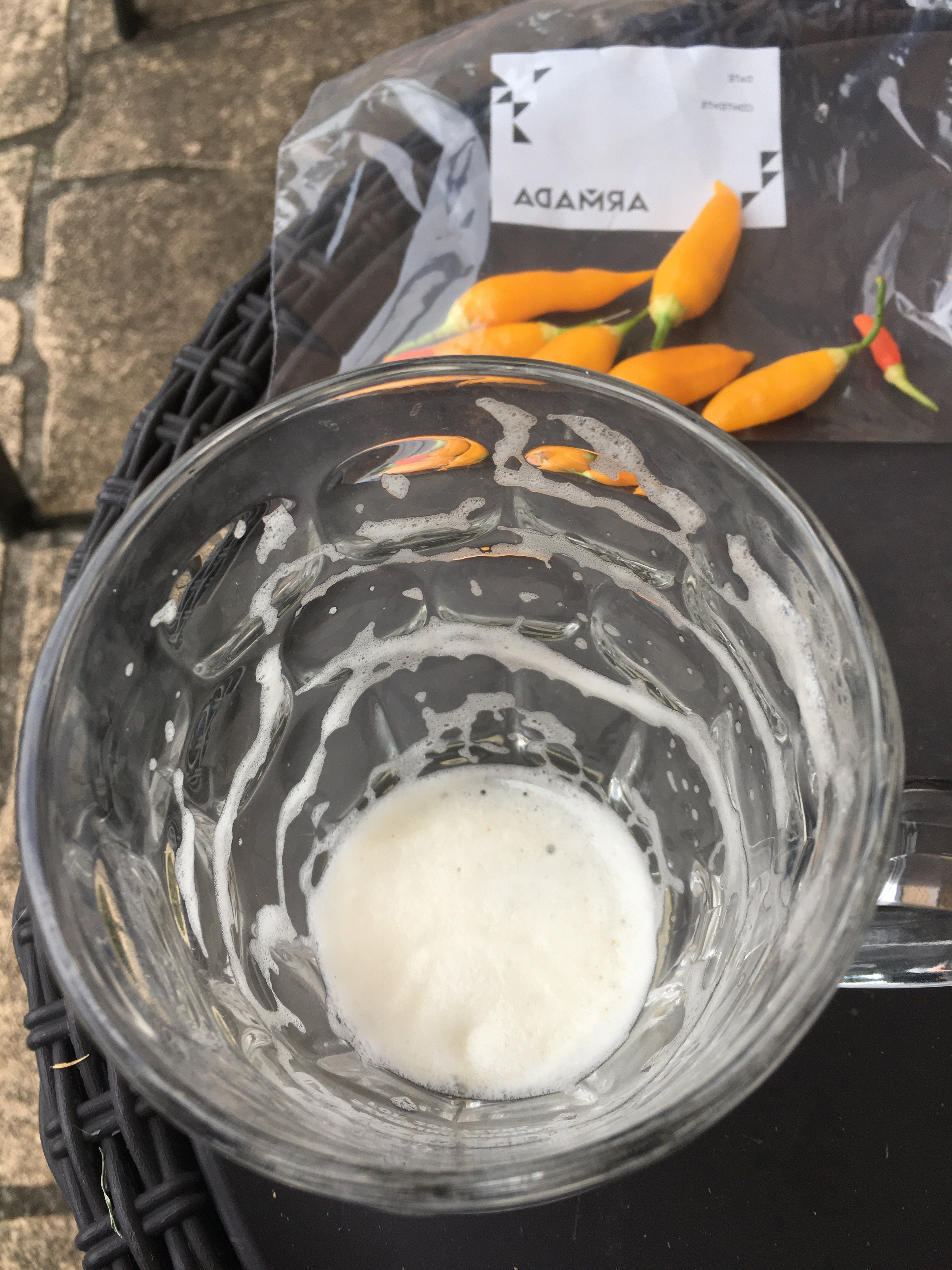There’s at least a theoretical concern with any fining agent that if you remove the proteins that make haze, you might also remove foam-promoting proteins. Foam says bentonite is bad, that silica and PVPP seem fine, and that isinglass removes lipids and thus improves foam. No mention of gelatin (which is not used commercially at the rates those others are.)Is that opinion or is there some authoritative source supporting this? This is the first time heard that.
You are using an out of date browser. It may not display this or other websites correctly.
You should upgrade or use an alternative browser.
You should upgrade or use an alternative browser.
best grain for foam?
- Thread starter Hoochin'Fool
- Start date

Help Support Homebrew Talk:
This site may earn a commission from merchant affiliate
links, including eBay, Amazon, and others.
I haven’t heard of gelatin reducing foam. I understand it could negatively impact foam related to proteins as it can drop some out of solution. My anecdotal experience with it has not shown this to be the case.
The APA I was referring to was not gelatin fined. As much as I appreciate crystal clear beer, I just let it be as a little haze doesn’t bother me in that style.
I just kegged a Pacific Pilsner that I will be fining with gelatin once it’s thoroughly chilled.
The APA I was referring to was not gelatin fined. As much as I appreciate crystal clear beer, I just let it be as a little haze doesn’t bother me in that style.
I just kegged a Pacific Pilsner that I will be fining with gelatin once it’s thoroughly chilled.
Barão
Well-Known Member
- Joined
- Jun 18, 2020
- Messages
- 191
- Reaction score
- 50
19 years experience.. read Charlie Bamforth.. the pope of foam formation and retentionIs that opinion or is there some authoritative source supporting this? This is the first time heard that.
I've just tried my ultra sonic apa after one week in the bottle. Usually my foam is bad at this stage. Like really bad. It's improving working the next few months, but at this point it's usually bad.
It wasn't. It was great. Like literally great. I've made multiple things in a different way so there's no way to figure it out exactly.
I've mashed single step at 69 degrees Celsius for sixty minutes.
I've included about 30% best XL.
I have high hopping rates for my standards and high ibus for my standards. About 45 ibus, mash hops , late additions and dry hops.
Ultra sonic bottling technique was used.
To sum it up, I think the main driver is the hopping rate, followed by the higher mash temperature (got good attenuation anyway) in combination with the best XL.
It wasn't. It was great. Like literally great. I've made multiple things in a different way so there's no way to figure it out exactly.
I've mashed single step at 69 degrees Celsius for sixty minutes.
I've included about 30% best XL.
I have high hopping rates for my standards and high ibus for my standards. About 45 ibus, mash hops , late additions and dry hops.
Ultra sonic bottling technique was used.
To sum it up, I think the main driver is the hopping rate, followed by the higher mash temperature (got good attenuation anyway) in combination with the best XL.
Halfakneecap
Well-Known Member

Malted Spelt saison at first pour

At the end.
- Joined
- Feb 16, 2012
- Messages
- 4,642
- Reaction score
- 7,061
- Location
- At home, in the brewery in Maryland.
A dextrin rest is a necessary tool to be used to improve body, but with chit malt a protein rest is still highly advised. Per the maltster:If you only do one step, you must do it at the upper end of the temp range. That's the key to develop decent foam, at least in my experience. 68c and above.
""... mash-in @ 131F with :20 rest (gum breakdown) reduces haze producing elements and promotes formation of FANs while not significantly reducing body or head retention."
I've got a Pivo Grodzeskie waiting to be brewed that uses a very slight touch of chit malt on top of the 95% smoked wheat grist bill. I'll def be using a 50C protein rest and a metric crap ton of rice hulls to boot, with all that wheat. Otherwise I'd likely get more sugars by sparging a concrete block.

$53.24
1pc Hose Barb/MFL 1.5" Tri Clamp to Ball Lock Post Liquid Gas Homebrew Kegging Fermentation Parts Brewer Hardware SUS304(Liquid Hose Barb)
yunchengshiyanhuqucuichendianzishangwuyouxiangongsi

$49.95 ($0.08 / Fl Oz)
$52.99 ($0.08 / Fl Oz)
Brewer's Best - 1073 - Home Brew Beer Ingredient Kit (5 gallon), (Blueberry Honey Ale) Golden
Amazon.com

$176.97
1pc Commercial Keg Manifold 2" Tri Clamp,Ball Lock Tapping Head,Pressure Gauge/Adjustable PRV for Kegging,Fermentation Control
hanhanbaihuoxiaoshoudian

$53.24
1pc Hose Barb/MFL 1.5" Tri Clamp to Ball Lock Post Liquid Gas Homebrew Kegging Fermentation Parts Brewer Hardware SUS304(Gas MFL)
Guangshui Weilu You Trading Co., Ltd

$76.92 ($2,179.04 / Ounce)
Brewing accessories 1.5" Tri Clamp to Ball Lock Post Liquid Gas Homebrew Kegging Fermentation Parts Brewer Hardware SUS304 Brewing accessories(Gas Hose Barb)
chuhanhandianzishangwu

$20.94
$29.99
The Brew Your Own Big Book of Clone Recipes: Featuring 300 Homebrew Recipes from Your Favorite Breweries
Amazon.com

$22.00 ($623.23 / Ounce)
AMZLMPKNTW Ball Lock Sample Faucet 30cm Reinforced Silicone Hose Secondary Fermentation Homebrew Kegging joyful
无为中南商贸有限公司

$33.99 ($17.00 / Count)
$41.99 ($21.00 / Count)
2 Pack 1 Gallon Large Fermentation Jars with 3 Airlocks and 2 SCREW Lids(100% Airtight Heavy Duty Lid w Silicone) - Wide Mouth Glass Jars w Scale Mark - Pickle Jars for Sauerkraut, Sourdough Starter
Qianfenie Direct

$33.98
DYKWSWYX Heavy Duty Brewing Gloves (1 Pair) - 55CM Long Chemical Resistant Plastic Gloves for Beer & Wine Making, Cleaning, Homebrew Equipment Protection
wuhanshijiayangzhiyimaoyiyouxiangongsi

$44.99
$49.95
Craft A Brew - Mead Making Kit – Reusable Make Your Own Mead Kit – Yields 1 Gallon of Mead
Craft a Brew
![Craft A Brew - Safale S-04 Dry Yeast - Fermentis - English Ale Dry Yeast - For English and American Ales and Hard Apple Ciders - Ingredients for Home Brewing - Beer Making Supplies - [1 Pack]](https://m.media-amazon.com/images/I/41fVGNh6JfL._SL500_.jpg)
$6.95 ($17.38 / Ounce)
$7.47 ($18.68 / Ounce)
Craft A Brew - Safale S-04 Dry Yeast - Fermentis - English Ale Dry Yeast - For English and American Ales and Hard Apple Ciders - Ingredients for Home Brewing - Beer Making Supplies - [1 Pack]
Hobby Homebrew

$719.00
$799.00
EdgeStar KC2000TWIN Full Size Dual Tap Kegerator & Draft Beer Dispenser - Black
Amazon.com

$479.00
$559.00
EdgeStar KC1000SS Craft Brew Kegerator for 1/6 Barrel and Cornelius Kegs
Amazon.com

$58.16
HUIZHUGS Brewing Equipment Keg Ball Lock Faucet 30cm Reinforced Silicone Hose Secondary Fermentation Homebrew Kegging Brewing Equipment
xiangshuizhenzhanglingfengshop

$7.79 ($7.79 / Count)
Craft A Brew - LalBrew Voss™ - Kveik Ale Yeast - For Craft Lagers - Ingredients for Home Brewing - Beer Making Supplies - (1 Pack)
Craft a Brew

$172.35
2 Inch Tri Clamp Keg Manifold With Ball Lock Posts, Pressure Gauge, PRV (0-30 PSI) – Homebrew, Fermentation, Kegging System
wuhanshijiayangzhiyimaoyiyouxiangongsi
After 2 subsequent brews, my vote is that 1% flaked wheat gives MUCH better foam (and long lasting foam) than any amount of carapils or any other alleged foam-enhancing grain.
You can just use malted wheat as well.
Did you incorporate a higher temperature rest in your test batch? Like 72c or 70c?After 2 subsequent brews, my vote is that 1% flaked wheat gives MUCH better foam (and long lasting foam) than any amount of carapils or any other alleged foam-enhancing grain.
DuncB
Well-Known Member
Big fan of the 72C rest.
- Joined
- Feb 16, 2012
- Messages
- 4,642
- Reaction score
- 7,061
- Location
- At home, in the brewery in Maryland.
In my five pilot batch test recipes for “the perfect Kolsch”, the main variable for foam enhancement has used different amounts and proportions of wheat, carafoam, and chit malt. The aggregate amount is ~10% of the grist. All have incorporated a 70C rest of :30 minutes before a 78C mash out.
Batch #5 is just about at Final Gravity. All have exhibited very good initial foam in the glass with excellent lacing that persists, leaving significant ‘notches’ with every sip.
Some batches were two or all three ‘foam adjuncts’ with the most foam coming with a combo of 4% wheat, 4% chit, 2% Carafoam. A better comparison will come after all the batches have ‘lagered’/conditioned for a few weeks.
Batch #5 is just about at Final Gravity. All have exhibited very good initial foam in the glass with excellent lacing that persists, leaving significant ‘notches’ with every sip.
Some batches were two or all three ‘foam adjuncts’ with the most foam coming with a combo of 4% wheat, 4% chit, 2% Carafoam. A better comparison will come after all the batches have ‘lagered’/conditioned for a few weeks.
No, just a full volume BIAB mash at 152F for 60 minutes, only dropped one degree in that time. Pulled the grain bag, squeezed the hell out of it, and went straight to boiling.Did you incorporate a higher temperature rest in your test batch? Like 72c or 70c?
90% briess brewer's malt
9% briess munich 10L
1% flaked wheat
Cascade @60 and @10
Citra @10 and in dry hop
s-04
Foam for days! Lighting here is crappy, but the beer is quite clear.

9% briess munich 10L
1% flaked wheat
Cascade @60 and @10
Citra @10 and in dry hop
s-04
Foam for days! Lighting here is crappy, but the beer is quite clear.

That looks like the Citra pilsner I brewed a month ago. Foam for days.
Similar threads
- Replies
- 20
- Views
- 1K
- Replies
- 5
- Views
- 374
- Replies
- 6
- Views
- 739









































